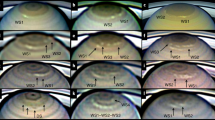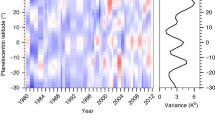Abstract
A giant storm, the Great White Spot, erupted at the end of September 1990 as a localized, bright cloud system close to Saturn's equator. Its evolution produced a complex planetary disturbance which affected the whole equatorial region a month later. Similar spots have appeared approximately once every saturnian year (about 30 Earth years), implying that a seasonal change—in solar heating, for example—may be responsible for their occurrence.
This is a preview of subscription content, access via your institution
Access options
Subscribe to this journal
Receive 51 print issues and online access
$199.00 per year
only $3.90 per issue
Buy this article
- Purchase on Springer Link
- Instant access to full article PDF
Prices may be subject to local taxes which are calculated during checkout
Similar content being viewed by others
References
Alexander, A. F. The Planet Saturn (Faber and Faber, London, 1962).
Sanchez-Lavega, A. Icarus 44, 1–16 (1982).
Sanchez-Lavega, A. & Battaner, E. Astr. Astrophys. Suppl. Ser. 64, 287–301 (1986).
Tomasko, M. G., West, R. A., Orton, G. S. & Tejfel, V. G. in Saturn (eds Gehrels, T. & Matthews, M. S.) 150–194 (University of Arizona Press, Tucson, 1984).
Smith, B. A. et al. Science 212, 163–191 (1981).
Smith, B. A. et al. Science 215, 504–537 (1982).
Ingersoll, A. P., Beebe, R. F., Conrath, B. J. & Hunt, G. E. in Saturn (eds Gehrels, T. & Matthews, M. S.) 195–238 (University of Arizona Press, Tucson, 1984).
Sanchez-Lavega, A. & Battaner, E. Astr. Astrophys. 185, 315–326 (1987).
Sanchez-Labega, A. Sky Telescope 78, 141–142 (1989).
IAU Circ. No. 5105 (1990).
Sanchez-Lavega, A. & Quesada, J. A. Planet. Space Sci. 36, 1381–1389 (1988).
Westphal, J. A. et al. Astrophys. J. 369, L51–L53 (1991).
Hunt, G. E., Godfrey, D., Muller, J.-P. & Barrey, R. F. T. Nature 297, 132–134 (1982).
O'Meara, S. J. Sky Telescope 81, 144–147 (1991).
Conrath, B. J. & Pirraglia, J. A. Icarus 53, 286–292 (1983).
Hainaut, O. The Messenger No. 62, 59–61 (1990).
Killen, R. M. Icarus 73, 227–247 (1988).
Suggs, R. M. thesis, New Mexico State Univ., Las Cruces (1984).
Van Hemelrijk, E. Earth Moon Planets 38, 217–235 (1987).
Bezard, B., Gautier, D. & Conrath, B. Icarus 60, 274–288 (1984).
Bezard, B. & Gautier, D. Icarus 61, 296–310 (1985).
Author information
Authors and Affiliations
Rights and permissions
About this article
Cite this article
Sanchez-Lavega, A., Colas, F., Lecacheux, J. et al. The Great White Spot and disturbances in Saturn's equatorial atmosphere during 1990. Nature 353, 397–401 (1991). https://doi.org/10.1038/353397a0
Received:
Accepted:
Issue Date:
DOI: https://doi.org/10.1038/353397a0
This article is cited by
-
An enduring rapidly moving storm as a guide to Saturn’s Equatorial jet’s complex structure
Nature Communications (2016)
-
Strong Temporal Variation Over One Saturnian Year: From Voyager to Cassini
Scientific Reports (2013)
-
Deep winds beneath Saturn’s upper clouds from a seasonal long-lived planetary-scale storm
Nature (2011)
-
A giant thunderstorm on Saturn
Nature (2011)
Comments
By submitting a comment you agree to abide by our Terms and Community Guidelines. If you find something abusive or that does not comply with our terms or guidelines please flag it as inappropriate.



